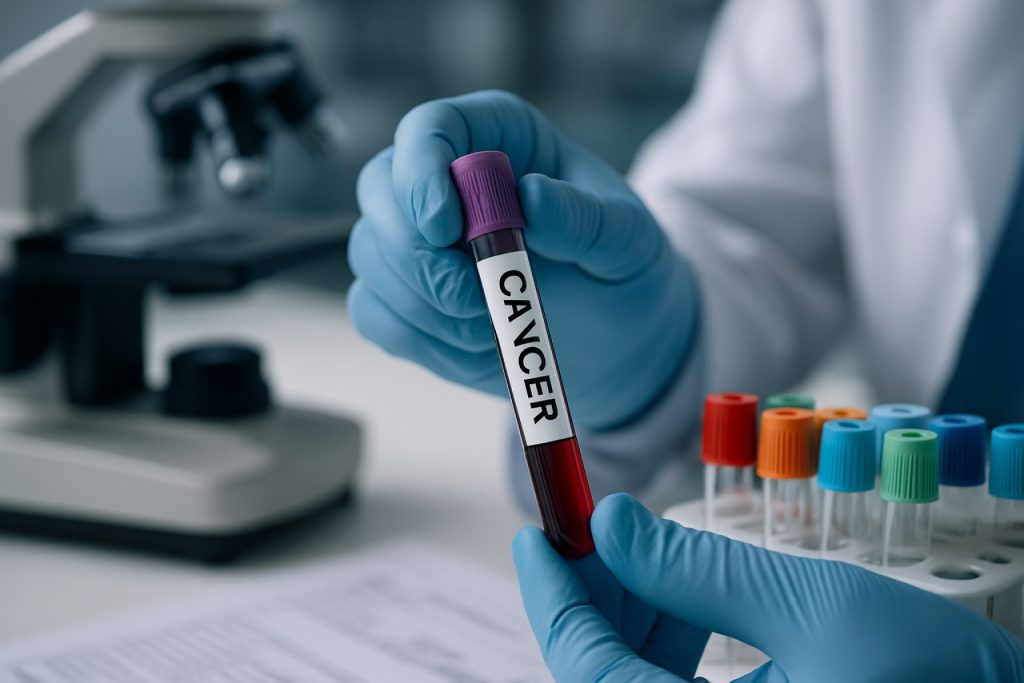
- Liquid biopsies use a blood sample to detect cancer early, offering a less invasive and more precise alternative to traditional tissue biopsies.
- Detecting early-stage cancer is challenging due to extremely low levels of tumor DNA in the blood.
- DNA methylation—chemical tags on genetic material—serves as a robust marker that can reveal cancer-specific patterns often missed by conventional tests.
- Recent innovations allow extraction of both genetic and methylation information from a single blood sample, improving sensitivity and preserving key epigenetic clues.
- Methylation-based liquid biopsies can identify not only the presence of cancer but also its tissue of origin with high accuracy.
- Ongoing research aims to refine these techniques for reliable clinical use, promising earlier diagnosis and better patient outcomes.
Syringes bristling with promise have become quiet revolutionaries on the clinical front. Liquid biopsies—a simple blood draw—now offer the tantalizing possibility of finding signs of cancer long before symptoms invade the body’s calm. No longer merely the stuff of research labs, this approach is shifting the landscape of cancer detection, promising less pain and greater precision than traditional invasive tissue biopsies.
But as powerful as these blood-based tests have become, they still battle a fundamental challenge: in early-stage cancers, telltale tumor DNA hides in astonishingly small quantities, easily missed by even the most discerning molecular scans. Scientists hunt for ways to sharpen their gaze, and recently their search has taken them to an overlooked genetic marker—DNA methylation.
Picture the genome not as a static script, but as a landscape constantly shifting in response to stress, environment, and age. Methyl groups—tiny chemical tags—attach themselves to the DNA, flipping genetic switches that can silence tumor-suppressing genes or wake oncogenes from their slumber. Patterns of DNA methylation emerge as cryptic fingerprints, uniquely altered in cancer. These epigenetic markers offer a dense map: unlike the rare point mutations sought by many conventional tests, methylation occurs in abundant clusters, potentially making even the faintest whispers of cancer much easier to detect in the blood.
Researchers leverage this abundance. In bustling labs across Europe, teams map methylation at tens of thousands of sites, training algorithms to distinguish malignant patterns from the background noise of healthy cells. For patients, this could mean earlier answers, greater hope—the chance to outpace cancer before it can tighten its grip.
Yet this promise is tangled in technical obstacles. One major frustration: extracting both genetic and methylation information from a needle’s worth of blood. Conventional workflows split each precious sample, halving already scarce DNA and sacrificing depth of analysis. Amplification steps vital for reading DNA often erase the very methylation clues scientists need most.
Innovation presses forward. New methods now allow for the separation of genetic and epigenetic data without splitting samples, preserving the original methyl groups and doubling the yield of information. These advances, developed in partnership with leaders like Agilent, dramatically increase sensitivity and streamline workflows, bringing precision testing closer to standard medical practice.
But transitions from bench to bedside are slow, and not without their own stumbling blocks. Scaling lab protocols for busy clinics, where speed and reliability are paramount, demands further refinement. Technologies that work well with isolated DNA fragments often struggle when tasked with reading repetitive genetic elements—common diagnostic signposts in multiple cancers.
The stakes are high. Methylation-based liquid biopsies don’t just flag the presence of cancer—they can offer forensic-level clues about its tissue of origin. Since each tissue harbors a unique methylation signature, scientists imagine a future where a simple blood draw not only detects malignancy early, but points physicians directly to its hiding place.
The critical task ahead: rigorously validating these methods so they can be deployed as clinical screening tools, reaching patients in hospitals and clinics worldwide. The implications stretch far beyond research, touching lives from the earliest moment of concern to the final promise of remission.
The takeaway is clear: Our DNA carries more than just genetic code—it hides epigenetic secrets that could unlock the next generation of cancer detection. Liquid biopsies empowered by DNA methylation analysis may soon redraw the boundaries of early diagnosis, delivering clarity with nothing more than a drop of blood. Yet scientific vigilance and innovation remain essential, as researchers push these technologies from the realm of possibility to the heart of everyday medicine.
For more on cutting-edge diagnostics and genomics, visit Nature and National Cancer Institute.
The Blood Test Revolution: How DNA Methylation Is Redefining Early Cancer Detection—What Doctors, Patients, and Investors Must Know
The Quiet Uprising of Liquid Biopsies: Beyond the Basics
Liquid biopsies, especially those leveraging DNA methylation analysis, are swiftly transforming the cancer diagnostic landscape. No longer purely experimental, these innovations are shifting standards for early detection, offering non-invasive, sensitive alternatives to traditional tissue biopsies. Yet, the technology, science, and market are moving rapidly. Here’s what readers need to know right now—covering practical use cases, how-tos, latest industry trends, and what’s just over the horizon.
—
Key Facts Not Covered Fully in Most Reports
1. How Do Liquid Biopsies Actually Work?
– Real-World How-To: Physicians draw a small vial of blood, extract circulating tumor DNA (ctDNA), and subject it to next-generation sequencing (NGS). In methylation-based tests, chemical treatments illuminate methylation patterns, helping algorithms pick up cancer-specific epigenetic signals ([Source: Mayo Clinic](https://www.mayoclinic.org)).
– Compatibility: Most tests are compatible with standard EDTA blood collection tubes, making them clinic-friendly.
2. What Makes DNA Methylation Better than Other Biomarkers?
– Density of Signals: Whereas point mutations in ctDNA can be rare (and easily missed), methylation patterns appear in dense clusters. This dramatically boosts sensitivity, especially in detecting early-stage or minimal residual disease.
– Tissue Origin: Each tissue—lung, breast, prostate, colon—has a unique methylation “signature,” enabling highly accurate identification of a tumor’s origin, critical for guiding next treatment steps.
– Clinical Impact: Studies in journals like Nature and Cell suggest methylation-based assays outperform mutation-only tests in both sensitivity and specificity, especially for hard-to-detect cancers.
3. Leading Tests, Features, and Pricing
– Commercial Players: Companies such as GRAIL (Galleri test), Guardant Health, and Agilent are forefronting these technologies ([Source: Agilent](https://www.agilent.com)).
– Features & Specs:
– Can detect over 50 cancer types (Galleri test, for example)
– Turnaround time: 7-14 days
– Sensitivity and specificity are cancer-type dependent; some report >90% specificity
– Pricing: The cost can range from $500 to $950 per test, though insurance coverage is currently limited, as these are not yet fully FDA-approved for population-wide screening ([Source: New York Times](https://www.nytimes.com)).
4. Current Limitations & Controversies
– Sensitivity in Stage I Cancer: While methylation boosts detection rates, tiny tumors may still shed vanishingly little DNA. False negatives remain a risk—patients should continue standard screening.
– False Positives: Some tests may pick up harmless “benign” methylation changes, especially in people with chronic inflammation or pre-cancerous conditions.
– Regulatory Scrutiny: The FDA is closely monitoring these tests; proper clinical validation in large, diverse populations is ongoing. There are concerns about overdiagnosis and overtreatment.
– Sample Handling: Pre-analytical factors (e.g., time to processing, temperature) can affect methylation preservation, requiring strict protocols.
5. Security, Sustainability, and Data Privacy
– Data Sensitivity: Genetic and epigenetic data require top-tier cyber protection. Reputable providers comply with HIPAA, GDPR, and seek to anonymize data.
– Sample Sustainability: Tests typically need only a few milliliters of blood, reducing medical waste compared to tissue biopsies,—and lowering infection risks.
6. Market Forecast and Trends
– Rapid Growth: The global liquid biopsy market is projected to hit over $6.1 billion by 2027, with methylation-based tests comprising the fastest-growing segment ([Source: MarketsandMarkets](https://www.marketsandmarkets.com)).
– Integration with AI: Machine learning is increasingly used to interpret complex methylation data, promising further improvements in accuracy.
– Expanding Use Cases: Beyond cancer, researchers are investigating methylation patterns for early detection of heart disease, neurological disorders, and transplant rejection.
7. Comparative Review: Methylation vs. Mutation Testing vs. Protein Biomarkers
| | Mutation-Based Liquid Biopsy | Methylation-Based Liquid Biopsy | Protein Marker Test |
|——————–|—————————–|——————————-|——————–|
| Sensitivity Early–Stage | Moderate | High | Low–Moderate |
| Identifies Tissue | Sometimes | Yes | No |
| Cost | $1,000+ | $500–$950 | ~$100 |
| FDA Approved | Some | Few in progress | Some |
| Main Limitation | DNA fragmentation | Interpretive complexity | Poor specificity |
8. Step-by-Step Tutorial: What to Expect as a Patient
1. Consultation: Discuss testing eligibility (personal/family history, symptoms, risk factors).
2. Sample Collection: Simple blood draw in clinic.
3. Lab Analysis: Blood is shipped to a CLIA-certified lab for DNA extraction and methylation mapping.
4. Results: Delivered to provider in 1–2 weeks; includes risk assessment and potential tumor origin.
5. Follow-Up: Further imaging or tissue biopsy may be recommended if cancer is detected.
9. Quick Life Hacks: Maximizing Test Accuracy
– Avoid heavy exercise 24 hours before the blood draw—physical stress may transiently alter methylation.
– Ensure fasting or not, as per clinic instructions.
– Confirm lab accreditation and inquire about result interpretation and next steps in advance.
—
Pressing Questions & Expert Answers
– Will methylation-based tests replace colonoscopies or mammograms?
Not yet. They complement—not replace—traditional screening. Used together, they increase overall detection rates, especially for people at higher risk ([Source: American Cancer Society](https://www.cancer.org)).
– Are there risks with unnecessary treatments?
As with any screening test, a small percentage of false positives may occur, potentially leading to anxiety or unneeded procedures. Professional counseling is crucial.
– Can these tests distinguish cancer from benign conditions?
Methylation patterns are generally cancer-specific, but unusual cases exist (e.g., inflammatory diseases), so results must be interpreted in a clinical context.
—
Pros & Cons Overview
Pros
– Non-invasive, simple blood draw
– Detects cancer earlier than symptoms appear
– Can identify tissue of origin
– Reduced complication and infection risk
Cons
– Some risk of false positives/negatives
– Not yet universally covered by insurance
– Best results in conjunction with conventional screening
—
Predictions: What’s Next?
– Broader clinical trials in asymptomatic populations to validate use as widespread screening.
– Even cheaper, faster tests as lab automation and AI mature.
– Integration into personalized oncology: predicting treatment response and monitoring remission with a drop of blood.
– Potential FDA approval and insurance coverage for high-risk groups within the next 2-4 years.
—
Actionable Recommendations & Takeaways
– If you’re at higher risk (family history, genetic predisposition, over age 50), discuss the availability and appropriateness of liquid biopsy with your doctor.
– Stay updated: New breakthroughs emerge monthly—professional resources like Nature and National Cancer Institute provide authoritative updates.
– When considering a “direct-to-consumer” test, verify regulatory status and clinical validation to avoid unproven or misleading offerings.
Bottom Line:
DNA methylation-based liquid biopsies represent a seismic shift in early cancer detection. They promise precise, pain-free clues about presence and origin with just a blood draw. While not a panacea yet, with ongoing advances and clinical validation, they are set to become an indispensable tool in the arsenal against cancer. Jump ahead by discussing these options with your healthcare provider—because the future of cancer screening starts with a single drop of blood.



